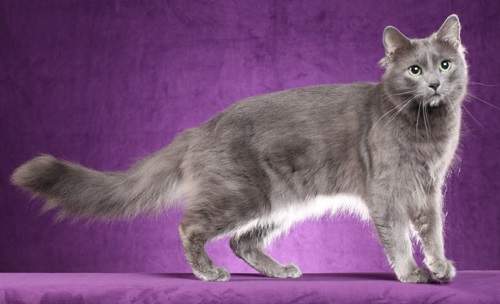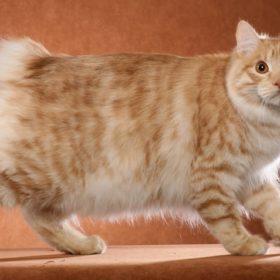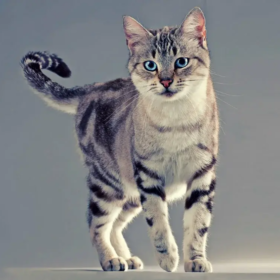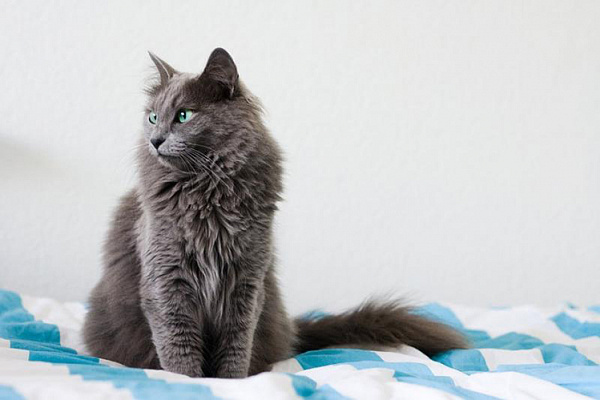Nebelung

Representatives of the breed are intelligent and reserved animals. They are kind to all family members, but often for themselves, they allocate one owner. With him, cats show more feelings and love to sit on their laps. At the same time, they do not require attention. If the atmosphere in the house is not favorable, the pets will not come up with petting.
Table of Contents
Breed Information
| Origin | United States |
| Size | Up to 25 cm |
| Weight | 3-5 kg |
| Fur Type | Semi-long-haired |
| Color | Blue, blue with a silvery cast |
| Lifestyle | Indoors |
| Lifespan | 15-18 years |
| FIFe Classification | – |
| WCF Classification | Group 2: “Semi-long-haired” Breed designation – NEB |
| TICA Classification | NB |
| Group | Long-haired cats, cats for apartments |
| Price | $400-600 |
Breed Photos
Origin History
Nebelungs are a relatively new breed of cat. They came into the world only in the second half of the twentieth century. In 1980, the son of IT specialist Cora Cobb received a black short-haired cat as a gift. After a while, she mated with a representative of Russian blue cats. As a result, five kittens were born in 1984. A long coat of blue color clearly distinguished one specimen. The family named him after Siegfried, the hero of the epic “Song of the Nebelungs.
In 1986, Cora Cobb decided to experiment. She crossed Siegfried with a cat with a much lighter coat than its predecessor. Thus, three babies with unusual appearances were born. Cora’s fanaticism led her to contact the International Cat Association (TICA). She wanted to establish the possibility of creating a breed formally. The experts concluded that the offspring were long-haired representatives of Russian blue cats. The only difference between the two breeds is hair length. Together with the experts, Cobb developed a standard, and the TICA officially recognized the cats in 1987. The animals were named Nebelung, either from the Germanic saga or from the German Nebel (fog).
The Russian Blue became an outcross for cats. It made it possible to improve the appearance of the breed. Successful breeding ended in 1988. Seven years later, the breed was recognized by the CFF, ACFA, WCF, and other independent European organizations. Today, animals live mostly in homes in Canada, the U.S., and Great Britain.
Appearance
Graceful and at the same time strong Nebelung hide a well-developed musculature under a layer of long hair. Sexual dimorphism is not strongly pronounced: cats are slightly smaller than cats. Representatives of the breed are recognized as medium-sized long-haired animals. However, the thick coats may seem that they are stunted. Cats have a wedge-shaped head with a flat skull. Their snout is well defined. The nasal bridge is a gray-blue shade. The large ears are rounded to the base. Oval eyes are medium in size. They are set wide and take on a deep green-yellow hue.
Ideally, the tail of a breed representative corresponds to the distance between the shoulder blades and the rump. It is covered with long hair. The rest of the Nebelung’s coat is of medium length with a long ponytail. It changes depending on the season: denser in winter than in summer. The color of the cat is blue. It has a grayish tint due to tipping.
Character
Representatives of the breed are intelligent and reserved animals. They are kind to all family members, but often for themselves, they allocate one owner. With him, cats show more feelings and love to sit on their laps. At the same time, they do not require attention. If the atmosphere in the house is not favorable, the pets will not come up with petting.
Nebelung is not particularly friendly with strangers. But when they feel a good attitude to themselves, they quickly make contact. If familiar friends come to visit, cats are happy to play with them. With frequent business trips and the absence of family at home, getting a dog or another cat is recommended. In this way, representatives of the breed will feel safe.
Care
Long hair cats need a lot of care. Otherwise, they are undemanding. At least three or four times a week, comb out your cat’s coat to get rid of dead particles. Pets handle cleanliness on their own. It is recommended to bathe the Nebelung no more than once every three months. Before bathing, absorbent cotton should be inserted into the ears to keep water out. But it is worth knowing that cats do not like bathing very much. Once a month, brush the pet’s teeth with a special toothpaste. Dry food is good for preventing tartar. Wipe the eyes daily with a wet cloth. Also, sharpen claws by one to two millimeters once a month.
Education
Although Nebelungs are naturally patient cats, you should not train them too vigorously and intensively. Their innate hunting instinct allows them to make their own decisions. Education is best done in the form of play. Don’t forget to praise the cat and give it a treat. It is recommended to train the main person in the house or the person, the cat, has chosen as an owner.
Common Diseases
Representatives of the breed are cats with good health. They often have diseases that long-haired animals suffer from shingles, worms, fleas, and ticks. If the situation is not neglected, these diseases are treated quickly. Nebelungs can also experience more serious ailments:
- cystitis;
- renal failure;
- urolithiasis;
- hyperthyroidism;
- diabetes.
Nutrition
It is recommended that baby Nebelungs be fed five times a day. As they get older, switch to two to three meals a day and increase portions. If you choose non-natural food, it is better to give preference to premium food. These contain essential vitamins and minerals for the cat’s full development. For a natural diet, eliminate it:
- carrots;
- beets;
- buckwheat porridge;
- liver;
- products with iodine and copper.
 Toybob (Skif-Thai-Don)
Toybob (Skif-Thai-Don) Kanaani
Kanaani Mekong Bobtail
Mekong Bobtail Kurilian Bobtail Longhair
Kurilian Bobtail Longhair Birman
Birman Asian (Tabby)
Asian (Tabby)


